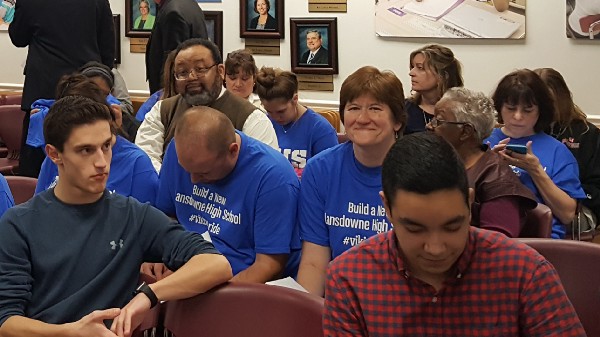Last night I attended a Baltimore County Board of Education meeting in support of parents and teachers advocating for a new Lansdowne High School. As I’ve written previously, I think it’s foolish to spend $60 million on a renovation that won’t even bring the schools up to 21st century standards. We can and must do better for our children.

But the problem is bigger than Lansdowne, Dulaney, and Towson, all of which need new high schools. Let’s not forget the other schools left out of the conversation. Johnnycake Elementary School, just a few blocks from my house, has current enrollment at almost 125% of the state rated capacity, with children attending classes in trailers. By the 2018 school year, the enrollment is projected to be at 130% of capacity, which would put it in the county’s “red” category, indicating urgent need. But it currently isn’t on the list for a new school, or even for a permanent addition to relieve overcrowding.
I credit current county leadership for their work so far. To be fair, they inherited a mess made by years of neglect of our schools. And they have spent significant money ($1.3 billion) in a genuine attempt to update schools and solve problems. But it isn’t enough when children still attend severely overcrowded and crumbling schools. Studies have clearly shown that the school environment affects student learning, and that overcrowding is linked to increased aggression, decreased student engagement, and less learning.
Yes, the county has limited money. Yes, fiscal responsibility is important. But how much is too much investment when it comes to our children? We also need to remember that every dollar spent on improving education will come back to us many times over, since better education leads to higher incomes, long-term mental and physical wellbeing, and increased teacher retention. New schools will increase property values, especially in neighborhoods where values are lower, leading to increased demand and investment in those neighborhoods, which in turn will increase county revenue.
We need to think creatively and carefully consider our priorities to fund the badly needed school infrastructure. For example, was it wise to spend $300 million dollars installing central AC in aging infrastructure that doesn’t meet 21st century standards? Instead, portable AC could have been installed for $10 million, allowing us to leverage that $300 million for buildings with secure building layouts, 21st century standards and central AC?
There are some specific, concrete steps that the county should take moving forward.
- A comprehensive and detailed ten-year plan, developed by an independent entity, with a full cost-benefit analysis, including maintenance costs for aging schools and long-term costs of inadequate education. The plan should fairly and clearly detail exactly when each school can expect to have its needs fully addressed, and short-term fixes for urgent needs until they can be alleviated by permanent facilities construction. We can’t keep pitting district against district in a yearly survival of the neediest.
- Greater collaboration between the County Executive, the County Council, Baltimore County Public Schools, the state, and the communities before any budgets are released. The current game of finger-pointing and tit-for-tat benefits no one and turns our children into chess pieces.
- Board of Education and County Council meetings shouldn’t overlap. Last night parents, advocates, and even Council members had to choose between the Council session and the Board of Education meeting.
- Considering other potential sources of revenue, such as developer impact fees.
There is no greater priority than education, even for those of us with no children or grown children. Education establishes the future of our county and our state. When the stakes are so high, we must replace our competing self-interests with commitment to our children and our communities.
Baltimore County Public Schools Systemwide Physical Facilities Assessment, December 2014
